Articles
- Page Path
- HOME > Korean J Community Nutr > Volume 17(6); 2012 > Article
-
Original Article
- Study on the Eating Habits and Practicability of Guidelines for Reducing Sodium Intake according to the Stage of Change in Housewives
- So-Hyun Ahn, Jong-Sook Kwon, Kyungmin Kim, Jin-Sook Yoon, Baeg-Won Kang, Jong wook Kim, Seok Heo, Hea-Young Cho, Hye-Kyeong Kim
-
Korean Journal of Community Nutrition 2012;17(6):724-736.
DOI: https://doi.org/10.5720/kjcn.2012.17.6.724
Published online: December 31, 2012
Department of Food Science & Nutrition, The Catholic University of Korea, Bucheon, Korea.
1Department of Food and Nutrition, Shingu College, Songnam, Korea.
2Department of Food and Nutrition, Baewha Women's University, Seoul, Korea.
3Department of Food and Nutrition, Keimyung University, Taegu, Korea.
4Department of Nutrition Policy, Food & Drug Administration, Chungbuk, Korea.
- Corresponding author: Hye-Kyeong Kim, Department of Food Science & Nutrition, The Catholic University of Korea, 43-1 Yeokgok 2-dong, Wonmi-gu, Bucheon, Gyeonggi-do 420-743, Korea. Tel: (02) 2164-4314, Fax: (02) 2164-4314, hkyeong@catholic.ac.kr
Copyright © 2012 The Korean Society of Community Nutrition
- 1,204 Views
- 3 Download
- 22 Crossref
Abstract
- This study was intended to investigate the sodium-related perception, dietary behavior, and practicability of methods for reducing sodium intake(RSI) according to the stage of change in consumers. The survey was conducted to 770 housewives, among them 553 subjects who answered the key questions for the stage of change were categorized into ''aintenance (M)' stage (maintaining reduced salt intake for more than 6 months; n = 287, 51.90%), 'Action (A)' stage (maintaining reduced salt intake for less than 6 months; n=139, 25.14%), and 'Pre-Action (P)'stage (not starting reduced salt intake; n = 127, 22.97%). The subjects in M and A were significantly older than those in P (p < 0.01). The scores of desirable dietary habit and dietary balance were the highest in M followed by A and P. When eating out, the subjects in P considered 'price' more and 'healthiness of food' less than those in M and A did. Among the guidelines for RSI, 'Avoid Processed Foods', 'Eat enough vegetables and fruits' and 'Add little amount of dipping sauce for fried food' were selected as the three easiest items to perform. With regard to the sodium-related perception, the subjects in M considered eating-out food to be more salty than homemade dishes, read nutrition labels more, avoided table salt or dipping sauce for fried food more, and had 'own low-sodium recipe' than those in P (p < 0.001). It is suggested that practicability of actions for RSI and the stage of change should be considered to develop effective personalized education program and nutrition guidance.
-
This research was supported by grants from Korea Food and Drug Administration fund (11162Sobiyeon165)
NOTES
- 1. Ahn Y, Kim KW. Beliefs regarding vegetable consumption, self-efficacy and eating behaviors according to the stages of change in vegetable consumption among college students. Korean J Community Nutr. 2012; 17(1): 1-13.Article
- 2. Anliker J, Damron D. Using the stage of change model in a 5 day guidebook for WIC. J Nutr Educ. 1999; 31(31): 175-176.
- 3. Brug J, Hospers HJ, Kok G. Differences in psychosocial factors and fat consumption between stages of change for fat reduction. Psychol Health. 1997; 12: 719-727.Article
- 4. Chobanian AV, Bakris GL, Black HR. The seventh report of the joint national committe on prevention, detection, evaluation and treatment of high blood pressure: the JNC 7 report. JAMA. 2003; 289: 2560-2572.ArticlePubMed
- 5. Cho MK. Development of education materials for lowing sodium intake and analysis of educational effects for elementary students. 2008; ChangWon National University; 73-180 MS thesis.
- 6. Contendo IR, Balch GI, Bronner YL, Lytle LA, Maloney SK, Olson CM, Swadener SS. The effectiveness of nutrition education and implications for nutrition education policy, programs, and research: a review of research. J Nutr Educ. 1995; 27(6): 277-422.
- 7. Cohen HW, Hailpern SM, Fang J, Alderman MH. Sodium intake and mortality in the NHANES II follow-up study. Am J Med. 2006; 119(3): 275.e7-275.e14.ArticlePubMed
- 8. Houston MC. Sodium and hypertensions. Arch Intern Med. 1986; 146: 179-185.ArticlePubMed
- 9. Kim HJ. Development of sodium usage behavior questionnaire and a case-control study on dietary factors related to hypertension in Koreans. 2006; Seoul National University; 72-77 Doctoral thesis.
- 10. Korea Food and Drug Administration. Korea Health Industry Development Institute. The office of National Assembly Sook-Mee Son, The Symposium of reducing sodium intake. 2010.
- 11. Korea Food and Drug Administration. Nutrition education material. 2012; cited 2012 August 1. Available from http://www.foodnara.go.kr/Na_down/res/contents/edudatalist.mk?na_ed_type=4.
- 12. Lee Y, Park HN. The effectiveness of Na education program in elementary school, -Six month follow-up study-. Korean J Community Nutr. 2010; 15(5): 603-613.
- 13. Ministry of Health and Welfare. Korea Health Industry Development Institute. The third Korea National Health Nutrition Examination Survey (KNHANES III), 2005 -Nutrition Survey (I, II). 2006.
- 14. Ministry of Health & Welfare. Korea Centers for Disease Control & prevention. 2010 National Health Statics. Korea National Health and Nutrition Examination Survey (KNHANES IV-3). 2011.
- 15. Mori K, Suzuki H, Wang DH, Takaki J, Takigawa T, Ogino K. Relationship of psychological factors with physical activity stage of change in prime-and middle-aged Japanese. Acta Med Okayama. 2009; 63(2): 97-104.PubMed
- 16. Miura K, Nakagawa H. Can dietary changes reduce blood pressure in the long term. Curr Opin Nephrol Hypertens. 2005; 14: 253-257.ArticlePubMed
- 17. National Heart, Lung, and Blood Institute. Your guide to lowering your blood pressure with DASH. 2006; [cited 2012 August 1].
- 18. Oh SY, Cho MR, Kim JO, Cho YY. Comparison of nutritional status and beliefs on health behavior regarding stages of change in dietary fat reduction among Korean men and women. Korean J Nutr. 2001; 34(2): 222-229.
- 19. O'Shaughnessy KM. Role of diet in hypertension management. Curr Hypertens Rep. 2006; 8(4): 292-297.ArticlePubMedPDF
- 20. Park YS, Son SM, Lim WJ, Kim SB, Chung YS. Comparison of dietary behaviors related to sodium intake by gender and age. Korean J Community Nutr. 2008; 13(1): 1-12.
- 21. Park YS, Lee CW, Suh CS, Lee BK, Lee HS. Nutrition education and counseling. 2010; Paju: Kyomunsa; 17-31.
- 22. Sim E, Kim JS, Ji JS, Sohn SM, Hwang TY, Chung JA, Chung EJ. The effects of a nutrition and body shape education program as part of health promoting projects in an elementary school. Korean J Nutr. 2010; 43(4): 382-394.Article
- 23. Son SM, Kim MJ. The effect of nutrition education program for various chronic disease in elderly visiting public health center. Korean J Community Nutr. 2001; 6(4): 668-677.
- 24. Son SM, Huh GY, Lee HS. Development and evaluation of validity of Dish Frequency Questionnaire (DFQ) and short DFQ using Na Index for estimation of habitual sodium intake. Korean J Community Nutr. 2005; 10(5): 677-692.
- 25. Son SM, Lee KH, Kim KW, Lee YK. Nutrition education and counseling practice. 2007a; Seoul: Life Science Publishing Co.; 26-29.
- 26. Son SM, Park YS, Lim WJ, Kim SB, Jeong YS. Development and evaluation of validity of short Dish Frequency Questionnaire (DFQ) for estimation of habitual sodium intake for Korean adults. Korean J Community Nutr. 2007b; 12(6): 838-853.
- 27. Suh Y, Chung Y. Comparison of mineral and vitamin intakes according to the stage of change in fruit and vegetable intake for elementary school students in Chungnam province. Korean J Nutr. 2008; 41(7): 658-666.
- 28. Taylor T, Serrano E, Anderson J, Kendall P. Knowledge, skills and behavior improvements on peer educators and low-income hispanic participants after a stage of change-based bilingual nutrition education program. J Community Health. 2000; 25(3): 241-262.PubMed
- 29. Yim KS. The effects of a nutrition education program for hypertensive female elderly at the public health center. Korean J Community Nutr. 2008; 13(5): 640-652.
- 30. Yon M, Lee Y, Kim D, Lee J, Koh E, Nam E, Shin H, Kang BW, Kim JW, Heo S, Cho HY, Kim CI. Major sources of sodium intake of the Korean population at prepared dish level -Based on the KNHANES 2008 & 2009-. Korean J Community Nutr. 2011; 16(4): 473-487.Article
REFERENCES
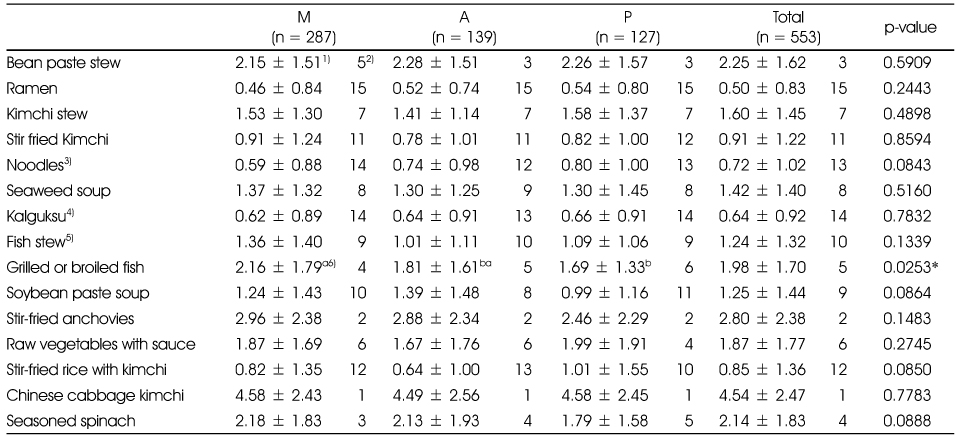
1) Mean ± SD
2) Rank within each group
3) Except bibimguksu, noodles mixed with vegetables and red pepper sauce
4) A kind of noodle dish made by cutting noodles from wheat-flour dough that has been rolled evenly thin.
5) Cooked with salty sauce and white radish or vegetables
6) Mean values are significantly different among the groups by DUNCAN's multiple range test
M = Maintenance stage, A = Action stage, P = Pre-Action stage
*: p < 0.05

Figure & Data
REFERENCES
Citations

- Factors affecting sugar intake in adults based on the social cognitive theory
Kilye Kim, Yeon-Kyung Lee
Journal of Nutrition and Health.2024; 57(1): 120. CrossRef - Changes in the importance and performance of low-sodium management among childcare center cooks in Yongin, South Korea, after salinometer support programs: a descriptive study
Jiwoo Min, Youngmi Lee, Yunhee Chang, Yujin Lee
Korean Journal of Community Nutrition.2024; 29(4): 304. CrossRef - Nutrition Quotient and Dietary Self-efficacy according to the Transtheoretical Model in Adolescent Athletes
Nahan Kim, Kwang-Seok Hong, In-Kyung Jung
Exercise Science.2022; 31(4): 499. CrossRef - Development and evaluation of a nutrition education program for housewives to reduce sodium intake: application of the social cognitive theory and a transtheoretical model
Sohyun Ahn, Jong-Sook Kwon, Kyungmin Kim, Hye-Kyeong Kim
Journal of Nutrition and Health.2022; 55(1): 174. CrossRef - Perceptions and Feasibility of Actions Related to Sodium Reduction among Restaurant Owners and Cooks in Seongnam, South Korea: Comparison According to Stages of Behavioral Change
So-Hyun Ahn, Jong-Sook Kwon, Kyungmin Kim, Hye-Kyeong Kim
Nutrients.2021; 13(12): 4375. CrossRef - Current status, perception and practicability of restaurant staffs related to reducing sodium use in Seongnam, Korea
So-Hyun Ahn, Jong Sook Kwon, Kyungmin Kim, Yoonna Lee, Hye-Kyeong Kim
Journal of Nutrition and Health.2019; 52(5): 475. CrossRef - Mobile application-based dietary sugar intake reduction intervention study according to the stages of behavior change in female college students
Yunjung Choi, Hyun-Sook Kim
Journal of Nutrition and Health.2019; 52(5): 488. CrossRef - Effect of a public health center-based nutrition education program for hypertension in women older than 50 years of age
Seoyun Park, Jong-Sook Kwon, Hye-Kyeong Kim
Journal of Nutrition and Health.2018; 51(3): 228. CrossRef - A Study on the Quality of Elderly Dietary Services by Different Levels of Nutrition Knowledge of the Visiting Long-Term Care Provider
Eun-Young Choi, Eun-Kyung Jung, Nami Joo
Journal of the East Asian Society of Dietary Life.2018; 28(1): 76. CrossRef - Comparison of Factors Influencing Change Stages in Balanced Diet among Female University Students in Korea and China
Mi Yeon Park, Chong Yu Ding, Pil Sook Park
The Korean Journal of Community Living Science.2017; 28(1): 45. CrossRef - Status of Recognition, Effort, and Satisfaction of Customers on Low-Sodium Diet in Industry Foodservice
Sang Jin Yoon, Kun Og Kang
Journal of the East Asian Society of Dietary Life.2017; 27(2): 168. CrossRef - Study of the characteristics of dietary behavior and the effects of nutrition education for sodium reduction according to the stages of behavioral change in sodium reduction of male adult subjects in Gwangju·Jeonnam regions
Young Ran Heo, Hyun Young Oh, Hee Kyong Ro
Journal of Nutrition and Health.2017; 50(5): 472. CrossRef - The Attitude towards, and Acceptance of Sodium-Reduced Products, and the Influences that Recognition of Sodium give to the Purchasing Intention of Sodium-Reduced Products - Focused on the Food Specialist -
Bo-Na Lee, Jin-woo Kim
The Korean Journal of Food And Nutrition.2016; 29(1): 52. CrossRef - Nutrition knowledge, eating attitudes, nutrition behavior, self-efficacy of childcare center foodservice employees by stages of behavioral change in reducing sodium intake
Yun Ahn, Kyung Won Kim, Kyungmin Kim, Jinwon Pyun, Ikhyun Yeo, Kisun Nam
Journal of Nutrition and Health.2015; 48(5): 429. CrossRef - A study on hypertension relevant nutritional knowledge and dietary practices in Chinese college students studying in South Korea
Zhe Sun, Wookyoun Cho
Journal of Nutrition and Health.2015; 48(5): 441. CrossRef - Development of dietary behavior items available in Korea National Health and Nutrition Examination Survey
A-Hyun Lim, Suk-Young Choi, Jae-Eun Shim, Ji-Yun Hwang, Hyun-Kyung Moon, Kirang Kim
Journal of Nutrition and Health.2015; 48(5): 407. CrossRef - Sodium-related Eating Behaviors of Parents and Its Relationship to Eating Behaviors of Their Preschool Children
Ye Seul Kim, Hong Mie Lee, Jung Hee Kim
Korean Journal of Community Nutrition.2015; 20(1): 11. CrossRef - A Comparison of Salty Taste Assessment, Dietary Attitude and Dietary Behavior among Adult and Senior Women by Region and by Age in Korea
Lin Jiang, Yun-Young Jung, Hyung-Sook Kim, Gi-Seon Nam, Jin-Sook Yun, Jong-Wook Kim, Yeon-Kyung Lee
Korean Journal of Community Nutrition.2015; 20(2): 109. CrossRef - Study on Sodium Reduction: 'Healthy Restaurant for Sodium Reduction'
Soon Myung Hong, Jee Hye Lee, Hye-Kyung Kim, Rina Yu, Jeong Hee Seo, Eun Jeong Huh, Seong Suk Cho, Jeongah Yang
Journal of the Korean Dietetic Association.2014; 20(3): 174. CrossRef - The Study on Dietary Behavior and Health Related Behaviors of Self Perceived Sodium Intake Groups
Juhyeon Kim, Hei-Ryeo Yoon, Nam-E Kang
Journal of The Korean Society of Food Culture.2014; 29(6): 511. CrossRef - Study on the Salt-Related Dietary Behaviors according to the Stage of Change Model for Salt-Related Intake of Middle School Students in Gyeongsangbuk-do Area
So-Young Park, Kyung-A Lee
Korean journal of food and cookery science.2014; 30(6): 687. CrossRef - Development of Nutrition Education Program for Consumers to Reduce Sodium Intake Applying the Social Cognitive Theory: Based on Focus Group Interviews
So-Hyun Ahn, Hye-Kyeong Kim, Kyung Min Kim, Jin-sook Yoon, Jong Sook Kwon
Korean Journal of Community Nutrition.2014; 19(4): 342. CrossRef
The distribution of subjects' stage of change for reducing sodium intake
1) N (%)
General characteristics according to the stage of change for reducing sodium intake
1) Mean ± SD: Mean values are significantly different among the groups by DUNCAN's multiple range test
2) N (%)
M = Maintenance stage, A = Action stage, P = Pre-Action stage
**: p < 0.01
General eating-habits according to the stage of change for reducing sodium intake
1) Mean ± SD: Mean values are significantly different among the groups by DUNCAN's multiple range test Score range = 0 - 3, Higher score means they have better dietary habits
M = Maintenance stage, A = Action stage, P = Pre-Action stage
**: p < 0.01, ***: p < 0.001
Eating-out characteristics according to the stage of change for reducing sodium intake
1) N (%)
2) Including bowl of rice served with toppings, food with soy sauce or other seasonings
3) Such as Ramen, noodles, and topokki
M = Maintenance stage, A = Action stage, P = Pre-Action stage
*: p < 0.05 by χ2-test among the group of stage of change
Dish consumption frequency according to the stage of change for reducing sodium intake
1) Mean ± SD
2) Rank within each group
3) Except bibimguksu, noodles mixed with vegetables and red pepper sauce
4) A kind of noodle dish made by cutting noodles from wheat-flour dough that has been rolled evenly thin.
5) Cooked with salty sauce and white radish or vegetables
6) Mean values are significantly different among the groups by DUNCAN's multiple range test
M = Maintenance stage, A = Action stage, P = Pre-Action stage
*: p < 0.05
Practicability of guidelines for reducing sodium intake according to the stage of change for reducing sodium intake
1) Mean ± SD: Mean values are significantly different among the groups by DUNCAN's multiple range test
2) Rank within each group
M = Maintenance stage, A = Action stage, P = Pre-Action stage
*: p < 0.05, **: p < 0.01, ***: p < 0.001
Perceptions related to sodium intake according to the stage of change for reducing sodium intake
1) N (%)
**: p < 0.01, ***: p < 0.001 by χ2-test among the group of stage of change
M = Maintenance stage, A = Action stage, P = Pre-Action stage
The subjects' needs for education methods
1) N (%)
M = Maintenance stage, A = Action stage, P = Pre-Action stage
1) N (%)
1) Mean ± SD: Mean values are significantly different among the groups by DUNCAN's multiple range test 2) N (%) M = Maintenance stage, A = Action stage, P = Pre-Action stage **: p < 0.01
1) Mean ± SD: Mean values are significantly different among the groups by DUNCAN's multiple range test Score range = 0 - 3, Higher score means they have better dietary habits M = Maintenance stage, A = Action stage, P = Pre-Action stage **: p < 0.01, ***: p < 0.001
1) N (%) 2) Including bowl of rice served with toppings, food with soy sauce or other seasonings 3) Such as Ramen, noodles, and topokki M = Maintenance stage, A = Action stage, P = Pre-Action stage *: p < 0.05 by χ2-test among the group of stage of change
1) Mean ± SD 2) Rank within each group 3) Except bibimguksu, noodles mixed with vegetables and red pepper sauce 4) A kind of noodle dish made by cutting noodles from wheat-flour dough that has been rolled evenly thin. 5) Cooked with salty sauce and white radish or vegetables 6) Mean values are significantly different among the groups by DUNCAN's multiple range test M = Maintenance stage, A = Action stage, P = Pre-Action stage *: p < 0.05
1) Mean ± SD: Mean values are significantly different among the groups by DUNCAN's multiple range test 2) Rank within each group M = Maintenance stage, A = Action stage, P = Pre-Action stage *: p < 0.05, **: p < 0.01, ***: p < 0.001
1) N (%) **: p < 0.01, ***: p < 0.001 by χ2-test among the group of stage of change M = Maintenance stage, A = Action stage, P = Pre-Action stage
1) N (%) M = Maintenance stage, A = Action stage, P = Pre-Action stage

 KSCN
KSCN
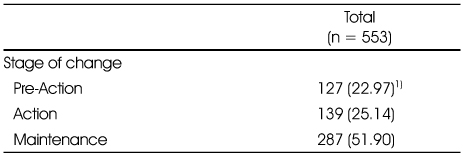
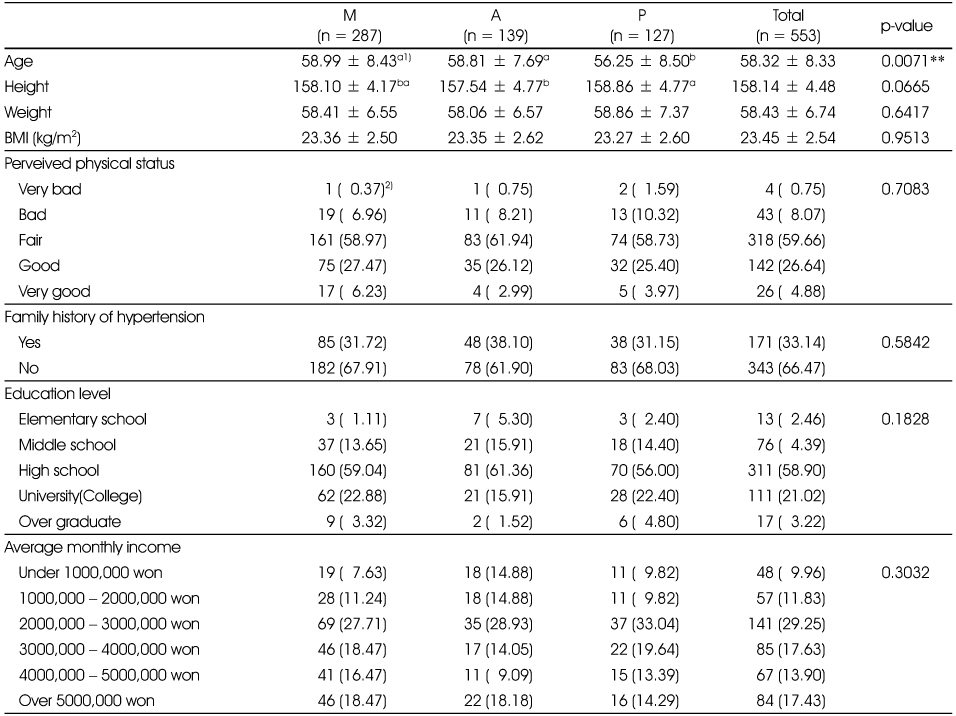
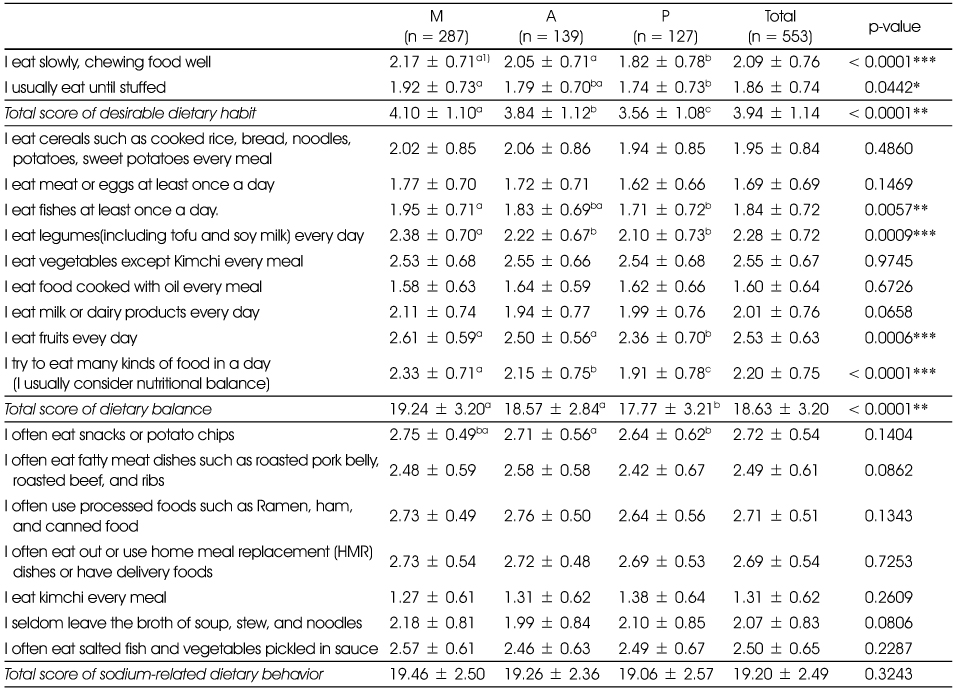
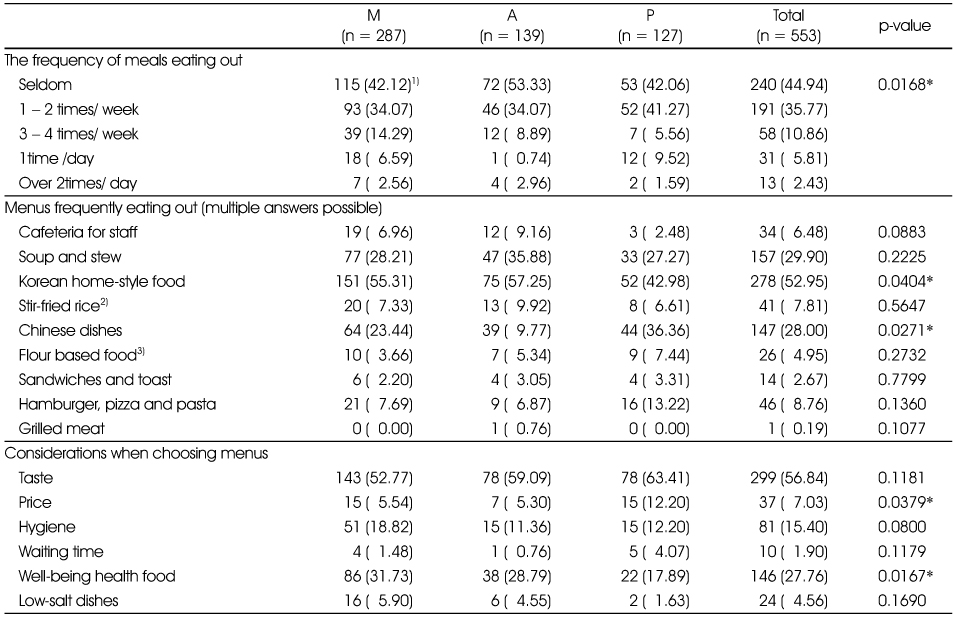
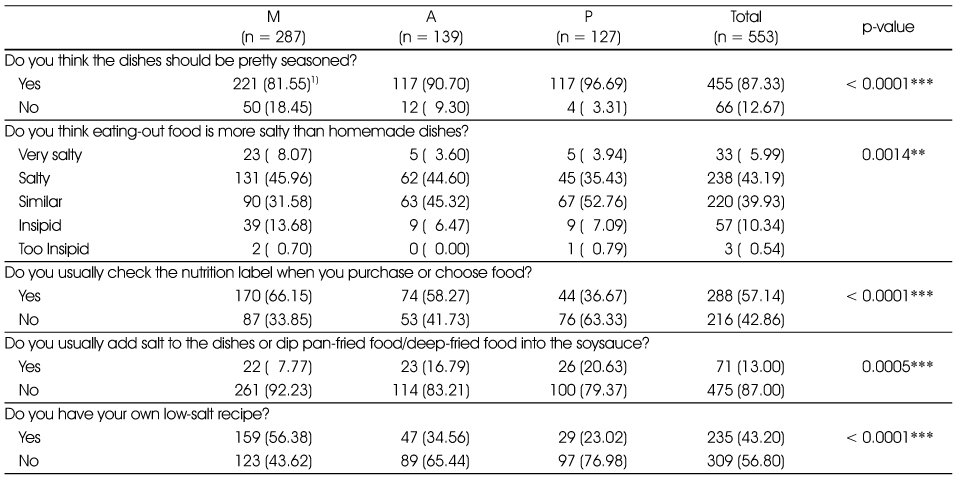

 Cite
Cite


